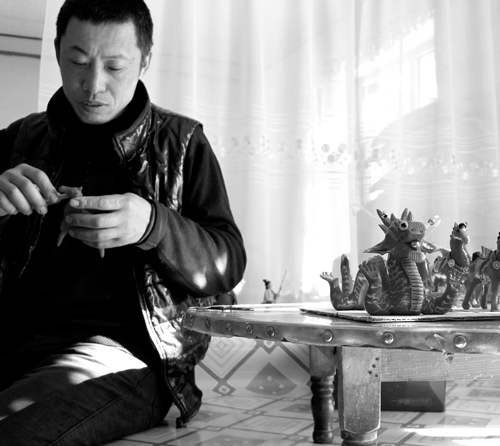
ZHU CHENGPEI/CHINA DAILY
Chen Dongzhu, from Moshifang village in Zhuanghe, Dalian, keeps his family tradition of making animal lanterns. He and his wife earn about 80,000 yuan ($13,200) from the trade every year.
Spring Festival revelers in Zhuanghe are snapping up animal lanterns representing the Chinese zodiac sign for the lunar year in which they were born. Zhu Chengpei and Zhang Xiaomin report on the fun and the tradition in Dalian.
Several days after the Lunar New Year, booths selling "animal lanterns" pop up on the streets of Zhuanghe of Dalian in Northeast China's Liaoning province. The lanterns are made of bean flour in the shapes of the animal signs of the Chinese zodiac, or shengxiao, which is composed of 12 animals (rat, ox, tiger, rabbit, dragon, snake, horse, sheep, monkey, rooster, dog and pig), each symbolizing a lunar year. The flames burn in external holders.
"It is a tradition in Zhuanghe that on the night of the Lantern Festival, which falls on Feb 14 this year, people ignite lanterns for each family member, wishing for good fortune," says Zhao Mou, who was buying a rat for her 5-year-old daughter, a rabbit for her husband and a monkey for herself on Tuesday at a booth in downtown Zhuanghe.
According to historical documents, migrating peasants from Shandong province brought the tradition of making animal lanterns to Liaoning during the first half of the 17th century. Nowadays, it only remains in Zhuanghe.
"When I was a little girl, my mother made animal lanterns by herself. But now most of the residents choose to buy them in the market instead. They are more beautiful and not expensive," Zhao says.
Dozens of booths are offering animal lanterns at the roadside market. Usually, a small lantern costs 5 yuan ($0.83). Bigger ones may cost a few dozen yuan or even more, according to their size and quality.
One booth owner, 31-year-old Yu Liang, says he has sold more than 1,000 lanterns a day over the past week.
"Every year, my parents and my maternal grandmother make about 20,000 animal lanterns. In the week before the Lantern Festival, they will all be sold," Yu says.
Many people retain the ability to produce the handicraft, he says, and every family that creates lanterns has their own designs. But without a doubt, the Chen family from the Moshifang village are the best, he says.
Chen Dongzhu, the elder brother of the Chen family, says his grandmother Tang Shu'e, who is now 94, learned the skill from her parents and handed it down to her daughter-in-law and her grandsons.
The family started to sell animal lanterns in the 1990s. About a decade ago, it could bring an annual income of 10,000 yuan. So Chen quit a more physical job and started to make a living making animal lanterns.
The family sells some lanterns to wholesalers and some directly to holiday revelers.
Every year, Chen and his wife begin making animal lanterns in October.
"As the lanterns are made of bean flour, they would not keep well," he explains.
So the production started later.
"The wholesalers are requiring more," he says. "But as they are all entirely handmade, we could produce no more than 30,000 lanterns before each Lantern Festival."
Their only daughter also gives a hand during her winter vacation. But she says she is not going to follow in her parents' footsteps.
"I will not make a living from it. But maybe someday I will learn it for my own interest," says Chen Cong, a junior in college majoring in Japanese.
Every year, her parents earn about 80,000 yuan from the lanterns. That is quite high among the villagers, who earn an average annual income of 17,000 yuan each.
In addition to the 12 Chinese horoscope animals, Chen sculpts some new images. For example, he makes a sea cucumber that sea-cucumber farmers can light while praying for a good harvest.
"People's living standards are improving. Folk artists should innovate accordingly," says Chen.
